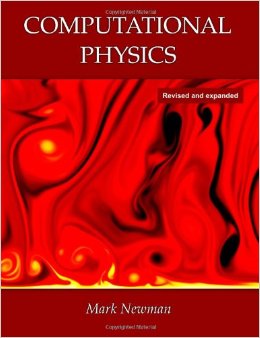
|
FreeComputerBooks.com
Links to Free Computer, Mathematics, Technical Books all over the World
|
|
- Title: Computational Physics with Python
- Author(s) Mark Newman
- Publisher: CreateSpace; eBook (University of Michigan Edition)
- Paperback: 562 pages
- eBook: PDF Files
- Language: English
- ISBN-10: 1480145513
- ISBN-13: 978-1480145511
- Share This:

|
This book is a complete introduction to the field of computational physics, with examples and exercises in the Python programming language. Computers play a central role in virtually every major physics discovery today, from astrophysics and particle physics to biophysics and condensed matter.
This book explains the fundamentals of computational physics and describes in simple terms the techniques that every physicist should know, such as finite difference methods, numerical quadrature, and the fast Fourier transform. The book offers a complete introduction to the topic at the undergraduate level, and is also suitable for the advanced student or researcher who wants to learn the foundational elements of this important field.
The Python programming language is an excellent choice for learning, teaching, or doing computational physics. This page contains a selection of resources the author developed for teachers and students interested in computational physics and Python.
About the Authors- N/A
- Python Programming
- Physics, Computational Physics, and Mathematical Physics
- Computational and Mathematical Simulations and Modeling

- Computational Physics with Python (Mark Newman)
- The Mirror Site (1) - PDF
- The Mirror Site (2) - PDF
- Resources for Instructors and Students
-
 Modeling and Simulation in Python (Allen B. Downey)
Modeling and Simulation in Python (Allen B. Downey)
This book is an introduction to physical modeling using a computational approach with Python. You will learn how to use Python to accomplish many common scientific computing tasks: importing, exporting, and visualizing data; numerical analysis; etc.
-
 Computational Physics with Python (Eric Ayars)
Computational Physics with Python (Eric Ayars)
This book provides an unusually broad survey of the topics of modern computational physics. Its philosophy is rooted in learning by doing, with new scientific materials as well as with the Python programming language.
-
 Computational Physics and Scientific Computing: C++ or Fortran
Computational Physics and Scientific Computing: C++ or Fortran
This book is an introduction to the computational methods used in physics, but also in other scientific fields. Both C++ or Fortran are used for programming the core programs and data analysis is performed using the powerful tools of the Gnu/Linux environment.
-
 Computational Physics: An Introduction (Franz J. Vesely)
Computational Physics: An Introduction (Franz J. Vesely)
A concise introduction to the methods and algorithms used in computational physics, clear in its presentation, useful for those beginning more advanced work in the field. Sample programs are be written in JAVA and are accompanied by short explanations.
-
 Programming for Computations - Python 3 Edition
Programming for Computations - Python 3 Edition
This book outlines the shortest possible path from no previous experience with programming to a set of skills that allows students to write simple programs for solving common mathematical problems with numerical methods in the context.
-
 Scipy Lecture Notes (Emmanuelle Gouillart, et al)
Scipy Lecture Notes (Emmanuelle Gouillart, et al)
This book teaches the scientific Python ecosystem, a quick introduction to central tools and techniques. It is for programmers from beginner to expert. Work on real-world problems with SciPy, NumPy, Pandas, scikit-image, and other Python libraries.
-
 Solving PDEs in Python: The FEniCS Tutorial I (H. Langtangen)
Solving PDEs in Python: The FEniCS Tutorial I (H. Langtangen)
This book offers a concise and gentle introduction to finite element programming in Python based on the popular FEniCS software library. Using a series of examples, it guides readers through the essential steps to quickly solving a PDE in FEniCS.
-
 From Python to NumPy (Nicolas P. Rougier)
From Python to NumPy (Nicolas P. Rougier)
NumPy is one of the most important scientific computing libraries available for Python. This book teaches you how to achieve expert level competency to perform complex operations, with in-depth coverage of advanced concepts.
-
 Introduction to Scientific Programming with Python
Introduction to Scientific Programming with Python
This book offers an initial introduction to programming for scientific and computational applications using the Python programming language. The presentation style is compact and example-based, assuming little or no prior experience in programming.
-
 Python for Everybody: Exploring Data in Python 3
Python for Everybody: Exploring Data in Python 3
This book is designed to introduce students to programming and software development through the lens of exploring data. You can think of the Python programming language as your tool to solve data problems that are beyond the capability of a spreadsheet.
-
 Automate the Boring Stuff with Python (Albert Sweigart)
Automate the Boring Stuff with Python (Albert Sweigart)
Learn how to use Python to write programs that do in minutes what would take you hours to do by hand - no prior programming experience required. You'll create Python programs that effortlessly perform useful and impressive feats of automation.





